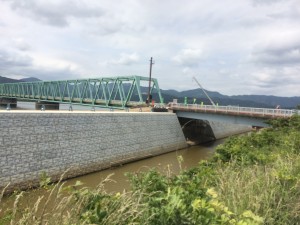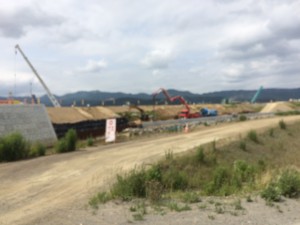Blog Post #5: Out with the Old
June 9, 2016
Driving through the mountains, along the shore of Onagawa, the thing that stands out the most is the reconstruction. Over five years after the tsunami has struck, it takes an earth scientist and one of the first volunteers to flock to the area to identify any lasting damage from the great wave. Freshly painted houses colonize the cliffs, roads and seawalls trace the shoreline, crisscrossed by glittering bridges. But the work is far from done, driving along the new road the cranes, trucks, and workers responsible for these structures and those awaiting completion are never out of site. It is hard to be melancholy about what is lost, when such titanic efforts have been made to rebuild.
But it is not the yet the same as it was before. Though the construction workers are everywhere, the people of this town are nowhere. Aside from a few fishermen tending to what appears to be very healthy oyster farms, there seem to be no people who aren’t attending to the construction. Searchingly, our Toyota scales the mountains, taking us into the residential neighborhoods. Though the new sea wall is much higher than its predecessor, it is not as high as the waves of the tsunami were; the architects of this new town know this well, placing it high above the crashing waves. As the ocean looms ahead of us, we turn to our left and to our right, inspecting the newly minted retrofitted houses. The closest people to us appear to driving along the main road, hundreds offeet below, transporting dirt in their cute little japanese dump trucks. The houses seem to be empty.
We drive through the cliffs to view the entire bay, lined by buoys signifying oyster lines. We get lost among the new residences, our guide makes k-turns without checking for other cars; there is no need. We drive parallel to the sea wall and watch trucks and cranes flatten the earth among the deforested mountains to make room for more rows of houses. After we think we have seen the entire bay, we stop by a temporary shopping center. I use the bathroom and go into an empty convenience store and purchase a piece of freshly baked custard filled bread for ¥110. The old man thanks me and bows, smiling broadly. It was delicous; I should have bought two. The end of the massive construction is in sight, it seems that any japanese citizen, or anyone who has seen the destruction can take pride in what has been done here since. But this place will not be recovered until new businesses settle here, until the shinto temples see worshippers, until the the houses become homes.


Leave a Reply